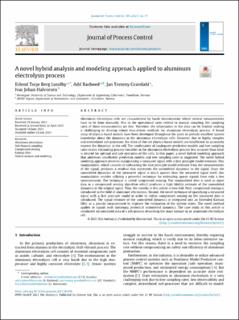| dc.contributor.author | Lundby, Erlend Torje Berg | |
| dc.contributor.author | Rasheed, Adil | |
| dc.contributor.author | Gravdahl, Jan Tommy | |
| dc.contributor.author | Halvorsen, Ivar Johan | |
| dc.date.accessioned | 2022-01-19T12:10:05Z | |
| dc.date.available | 2022-01-19T12:10:05Z | |
| dc.date.created | 2021-07-24T14:31:38Z | |
| dc.date.issued | 2021 | |
| dc.identifier.citation | Journal of Process Control. 2021, 105, 62-77. | en_US |
| dc.identifier.issn | 0959-1524 | |
| dc.identifier.uri | https://hdl.handle.net/11250/2838244 | |
| dc.description.abstract | Aluminum electrolysis cells are characterized by harsh environments where several measurements have to be done manually. Due to the operational costs related to manual sampling, the sampling rates of these measurements are low. Therefore, the information in the data can be limited, making it challenging to develop robust data-driven methods for aluminum electrolysis process. A broad array of physics-based models have been developed throughout the years to provide excellent system knowledge about the dynamics in the aluminum electrolysis cells. However, due to highly complex and interrelated sub-processes, the state-of-the-art physics-based models are insufficient to accurately express the dynamics in the cell. The combination of inadequate prediction models and low sampling rates makes estimating process variables in the aluminum electrolysis process less accurate than what is desired for optimal and safe operation of the cells. In this paper, a novel hybrid modeling approach that addresses insufficient prediction models and low sampling rates is suggested. The novel hybrid modeling approach involves manipulating a measured signal with a first principle model estimate. This manipulation, which consists of subtracting the first principle model estimate from the measurements of the signal, produces a residual that represents the unmodeled dynamics in the signal. Since the unmodeled dynamics of the measured signal is much sparser than the measured signal itself, this manipulation enables utilizing a powerful technique for estimating sparse signals from only a few measurements. The technique is called compressed sensing. The manipulated data is used as input data in a compressed sensing algorithm which produces a high fidelity estimate of the unmodeled dynamics in the original signal. Thus, the novelty in this article is two-fold. First, compressed sensing is introduced to the field of aluminum electrolysis. Second, the novel technique of sparsifying a measured signal with a first principle model in order to utilize compressed sensing on the measured data is introduced. The signal estimate of the unmodeled dynamics is integrated into an Extended Kalman filter as a pseudo measurement to improve the estimation of the system states. The novel method applies to signals with stationary periodical unmodeled dynamics. The case study in this article is conducted on simulated data of a sub-process describing the mass balance in an aluminum electrolysis cell. | en_US |
| dc.language.iso | eng | en_US |
| dc.publisher | Elsevier Science | en_US |
| dc.rights | Navngivelse 4.0 Internasjonal | * |
| dc.rights.uri | http://creativecommons.org/licenses/by/4.0/deed.no | * |
| dc.title | A novel hybrid analysis and modeling approach applied to aluminum electrolysis process | en_US |
| dc.type | Peer reviewed | en_US |
| dc.type | Journal article | en_US |
| dc.description.version | publishedVersion | en_US |
| dc.source.pagenumber | 62-77 | en_US |
| dc.source.volume | 105 | en_US |
| dc.source.journal | Journal of Process Control | en_US |
| dc.identifier.doi | 10.1016/j.jprocont.2021.06.005 | |
| dc.identifier.cristin | 1922545 | |
| dc.relation.project | Norges forskningsråd: 294544 | en_US |
| cristin.ispublished | true | |
| cristin.fulltext | original | |
| cristin.qualitycode | 2 | |

